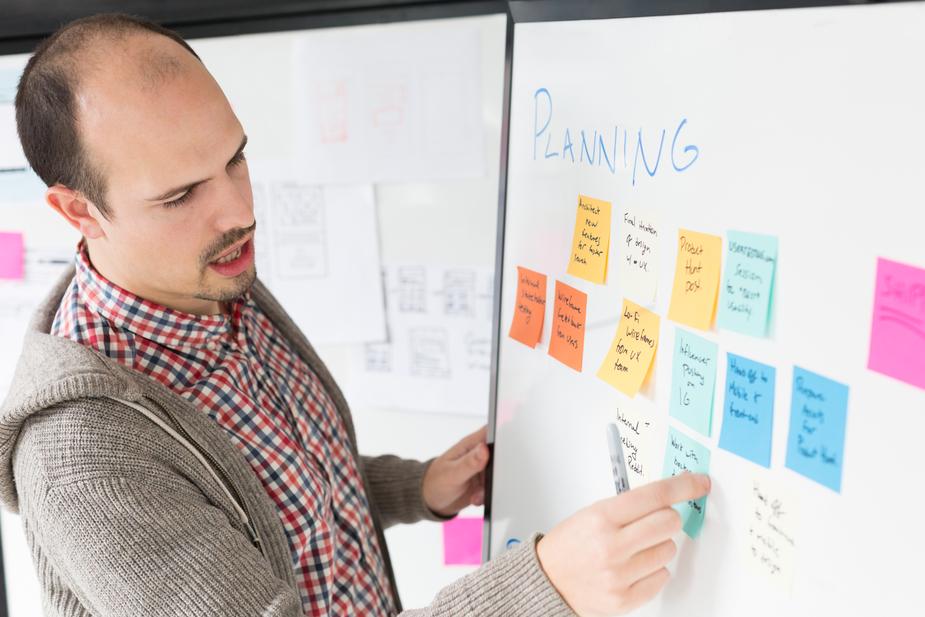Implementing More Employee Think Time
May 14, 2019 | People Management | No Comments

Dear CFO,
Our company is constantly trying to encourage employees to think creatively so we can stay ahead of the competition. A recent discussion with my boss led to a conversation about employee contribution, specifically on how to stimulate new ideas and innovative thinking from our team. The problem is, everyone is busy keeping up with his or her job. What are some ways as a Project Manager, I can foster ideas and add employee think time to the schedule (without falling behind)?
Keeping Busy with No Time to Think, Omaha

The logistics of fitting in employee think time can be very challenging, especially in an environment where the demands are high. But giving employees time to mull over problems and come up with innovative solutions means taking the pressure off. Chris Winfield at Inc. writes that companies like 3M are seeing the importance of building in employee think time to the schedule. Downtime and brain breaks are important—the challenge comes when we’re trying to get upper management on board with the idea of employee think time, especially in a world that’s all about productivity.
I personally experienced similar situations, both where I was in charge, but I was too busy to figure out a better way to add employee think time into the day (even though I knew a solution must exist). Or, I knew the way to make our schedules better for problems solving time, but no one above me would listen. I hope you are not in either of those situations. Buy-in from upper management is critical to making employee think time part of the routine.
When Management Gets in the Way
Whether you’re the top brass or you’re stuck somewhere in the middle of the chain of command, it’s important to the health of the business that everyone buys in and supports the idea of employee think time or creative time.
Many of us think creative time is just for creative offices, but all types of industries can benefit from additional employee think time (as well as think time for management). How many people come up with their best ideas in the shower? Why? Because when we’re able to finally relax and step away from a problem we can often gain perspective and insight.
Yet, oftentimes, with deadlines and quotas, we forget that people don’t usually do their best work under pressure. Over the course of my career, I observed this phenomenon time and time again:
- – Management that isn’t willing to wait even a day or two while you derive a more efficient way to do the reporting they require, or superiors who refuse to give you extra time to streamline your job or address an issue you notice amiss outside your department.
- – Management that only listens to outside consultants. While I believe consultants can add needed perspective, the roots of many of their suggestions arise from employee discussions, and even discontent voiced to management in the past. This misstep makes employees feel undervalued and ignored at best, and in the worst scenarios, like their jobs are at risk.
- – Management that expects clean up to happen at the end of the line rather than examining, addressing, and fixing the root cause of the problem. This scenario creates additional work and consumes time that could be used as employee think time to resolve the larger issue.
- – Individuals who are afraid to speak up and offer suggestions to upper management, because the boss already knows the “best way” and refuses to listen (and in some cases, even punishes them for their perceived criticism).
- – Especially outside of the tech and creative industries, management that often views employee think time as idleness and thus discourages it.
- – Incremental improvements that go unnoticed and get lost in the shuffle. Management that has a predisposition to the BIG idea and loses peripheral insight into other problems.
Let’s assume (and hope) you don’t work in an organization where management stifles ideas by the very way they manage. That addresses the first couple of bullet points on the above list. Quality organizations recognize that new ideas, streamlining, and process improvement have to be built into a healthy office culture.
Think your company is falling into any of these traps? The truth is, new ideas often come from a new perspective on an old problem. Employee think time requires both engagement and energy, so individual performance should be taken into account. Some employees are simply better suited and more comfortable with open creative time, whereas others prefer guidance and structure. Using ideation can be a great way to generate new, innovative ideas and is a good way to begin employee think time, especially if it’s new to your office.
According to Mark Twain, “There is no such thing as a new idea. … We simply take a lot of old ideas and put them into a sort of mental kaleidoscope. We give them a turn and they make new and curious combinations. We keep on turning and making new combinations indefinitely; but they are the same old pieces of colored glass that have been in use through all the ages.”
While I’m not sure how Mr. Twain would react to the technological changes of the last century, there is a strong element of truth to the concept of taking old ideas and making new combinations. The question to be addressed is what does the process for making new idea combinations look like?
Leading Employee Think Time By Example

Generating new ideas requires employee think time for your entire office, not just your creative staff or marketing team. Great ideas can come from anyone. As a leader, encouraging and allowing employee think time is critical in this hyper-competitive world. In fact, the idea of employee think time should be promoted, with all industries following the lead of the tech and creative industries. Idea generation, innovation, and employee think time is productive and should be encouraged.
As a leader you should do the following to foster employee think time and creative approaches in your office:
- – Lead by example. Make sure your team sees you allocating time to thinking on your own schedule. As a manager, I would take two Thursdays a month, go to a coffee shop from 7am to 9am and read on the industry, leadership, and other topics to stimulate my thinking. I know another senior exec. who gets to the office at 7am every day to start his day with think time, where he can ponder personnel, supply chain, and other issues of his industry.
- – Allocate employee think time for your team and give them a place to do it. Offering a small conference room or an offsite option on a regular basis encourages your team to work on their role, not in it. It’s important to let them know, they shouldn’t limit their thinking to their role or department; remind them they bring a fresh perspective to other parts of the business too.
- – Take into account the individuality of your team to optimize their engagement and energy around employee think time.
- – Some workers may thrive in a group environment and others need quieter surroundings
- – Some people are raring to go at 7am and others reach their creative peak at 10pm
- – Some employees may relish the interaction of debate, with quick responses and heated discussion, while others are more deliberate and contemplative in their responses
- – Allocate specific time to work on problem-solving, either group or private, on a regular basis. Some organizations require daily check-ins, while it’s more common to see weekly or monthly allocations in most business settings
- – Keep in mind, unproductive meetings or lack of direction will add to the workload instead of solving problems and your team will quickly lose interest.
- – Be sure to recognize innovative ideas, accomplishments, and progress whether in private or public
- – Train team members in a number of ideation techniques to help get the ideas started and encourage their implementation of the idea-generating techniques. As leadership, you don’t need to be involved in every brainstorming session. Instead, have a process for documenting the problem they are solving, the ideas generated, the selection and review process, and any documentation needed to acquire the approvals needed to proceed.
Actively seeking new perspectives might mean adding someone from outside the department or company to your problem solving. Alternatively, moodling or noodling on an issue passively creates new perspectives
Implementing New Ideas from Employee Think Time
So, now you made time to come up with all these great ideas, the question becomes, how do you get from idea to implementation?
First of all, don’t expect easy answers. Sometimes the implementation process requires extreme effort and contribution from the team that goes above and beyond the norm. In the case of something like a major system implementation, it may take time and assessment before it’s deemed feasible. For other small-scale innovative suggestions, you can work within the time constraints of your individual departments.
To implement new ideas generated during employee think time:
- – Sneak in incremental Improvements. You may not be able to tackle the whole improvement right now, but you can make time to take the next small step toward the big improvement. At the department level, incremental gets the job done. As Shane Fielder says, “incremental improvement done imperfectly, over time, produces monumental results”.
- – Take advantage of downtime. Most departments have an ebb and flow to the workload. For example, accounting is really busy right after month end, but often has a bit of a lull in mid-month. Take advantage of the slower schedule by using that time for implementation of the new ideas.
- – Break BIG ideas into incremental improvements. Rather than trying to tackle everything at once, split up the process into manageable tasks. Big ideas move your company in a new direction. It’s important that there’s a focus around innovative, big ideas, and the strategies to implement them. But remember, most BIG ideas break down into a series of steps, and those incremental tasks are easier to sneak into the crevices of the day.
- – Create the implementation timeframe thoughtfully and reward performance as you go along. Some projects require a short timeframe and condensed efforts (such as a system conversion) while as bigger projects, like improving the procedure documentation process, can happen over a longer timeframe. Both short and long-term projects require a level of recognition commensurate with the efforts involved.
While implementing employee think time will result in many benefits for your team, keep in mind that employee think time isn’t its own reward for most of your team. Even when offering employee think time becomes an embedded process in your office, it is still important to recognize the benefits of the ideas created.

Create processes to capture the great ideas that your team generates, as well as methods to measure improvements. Regularly scheduled weekly meetings that focus on progress against “Big Rocks,” (a Covey term used in the EOS system) or metrics specific to improvements (for example, reducing days sales outstanding from 45 to 30 days) will help keep your team on track.
Good luck as you implement more employee think time for your team. One of the most important pieces to remember is to always reward your team for performance. Celebrate the wins and help them to recognize the value of their great ideas!
Featured image and all post images licensed via Burst.


